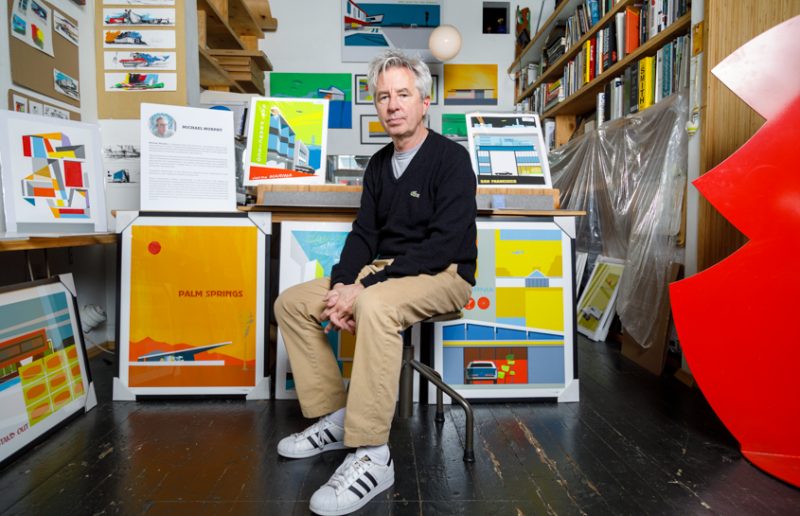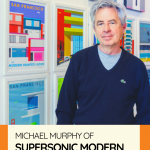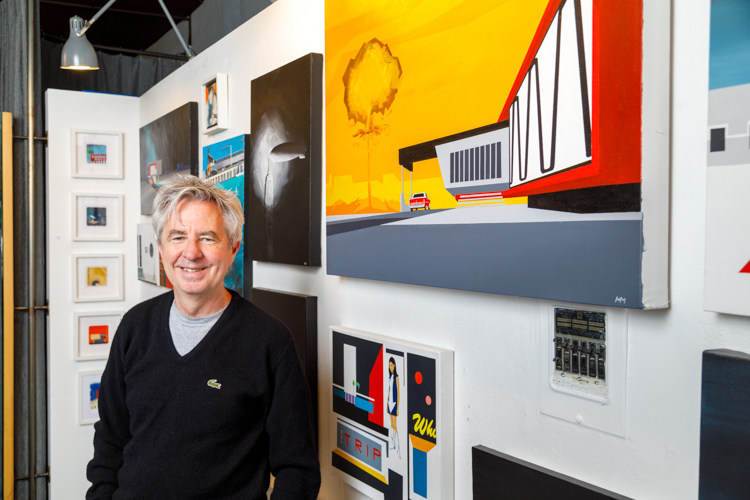
I first came across the work of artist Michael Murphy of Supersonic Modern while browsing at Pelago, a gift and housewares shop located in downtown Palm Springs. His prints with their precise lines and bright blocks of colors of mid century modern masterpieces lined the walls of the shop.
Modern architectural masterpieces from Chicago, Los Angeles, San Francisco and of course, Palm Springs were all on display in all their mid century glory. There was the Albert Frey designed Tramway Gas Station, the LAX Theme Building, and the Capital Records Building. And of course the residences designed by Krisel and Wexler. He called this collection of prints, Forgotten Modernism.
The simple, clean lines sum up what I admire about mid century modern architecture — no fuss and functional. And the bright colors of the prints seem appropriate for the optimistic mood of the mid century modern masters as they changed the world of architecture in the 1950s and 1960s with their designs.
All of a sudden I spotted his art work everywhere. While touring mid century modern homes during Modernism Week in Palm Springs and at a public art kiosk along a street in San Francisco — there they were. Intrigued, I discovered Murphy had recently opened a gallery, Supersonic Modern, located in the North Beach neighborhood of San Francisco.
So, I paid a visit. The front windows of the small shop located on Grant Street were filled with his paintings and prints as was the shop itself. A small work area located in the back was used as his art studio during gallery hours.
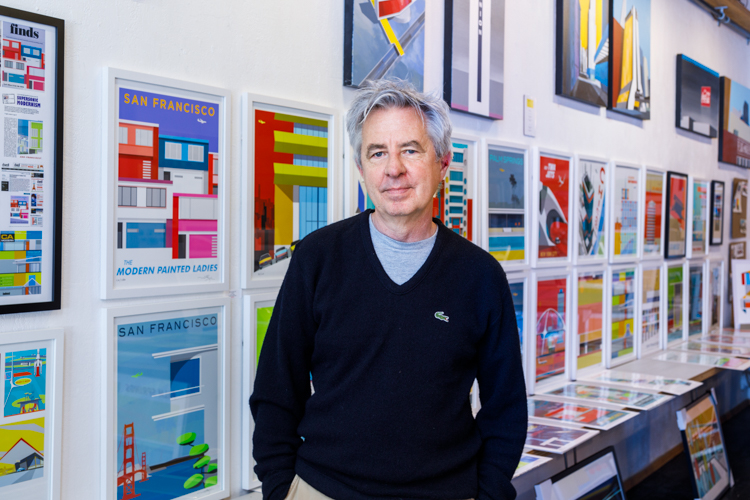
Why did you decide to focus on mid century modern architecture?
Oddly enough it actually started when I moved to Europe. I was born in San Francisco but grew up in South San Francisco. I went to the University of Mexico for my architecture degree. After I finished my degree I worked as an architect in San Francisco briefly before deciding to head to Ireland in 1998 to be with my girlfriend who was from there. The relationship didn’t last but I decided to stay in Ireland where I worked in an architect firm. I eventually met my wife there as well — she is from Spain and is also an architect. I was there for four years then worked for a firm in London. I mostly worked on civic buildings.
While still living in London I started a series of prints that eventually became known as my Supersonic Modern work. Most of it was inspired by buildings I had seen in San Francisco. The first one was a series of drawings I did inspired by the modern masterpiece located in the Presidio in San Francisco, the Russell House, designed by Erich Mendelsohn.
I didn’t call it mid century modernism but instead American modernism felt like a more appropriate name to me. I just didn’t see this type of architecture in Europe. I also did prints of the Buddha Lounge and Li Po Lounge. They have a bit of a cold war feel to them hence the name Supersonic.
We decided we wanted to return to San Francisco in 2008 which of course couldn’t have been worse timing with the recession just starting. There were no architecture jobs to be found after my firm decided layoffs were needed after a big project was canceled.
I decided to focus on my art full time.
How did the series of Forgotten Modernism paintings and prints come about?
My wife and I honeymooned in Palm Springs and that is where I really got interested in the style of mid century modernism.
I wanted to highlight buildings that to me had faded into the background of what people see. They may see them everyday but they don’t actually see them anymore. And these buildings were in many American cities. They were just part of the fabric of our life but in my opinion didn’t get the attention they deserved.
What is creative process? Where do you get your ideas?
The paintings take about six months to generate an idea and a week to actually paint it. Of course I work on multiple projects at a time. I get an idea then think about it. I do a little sketch. Revisit it. Sit there and think about it. Then eventually get down to work!
Ideas come to me from a lot of places. Things I read and see online. Instagram is interesting to get ideas.
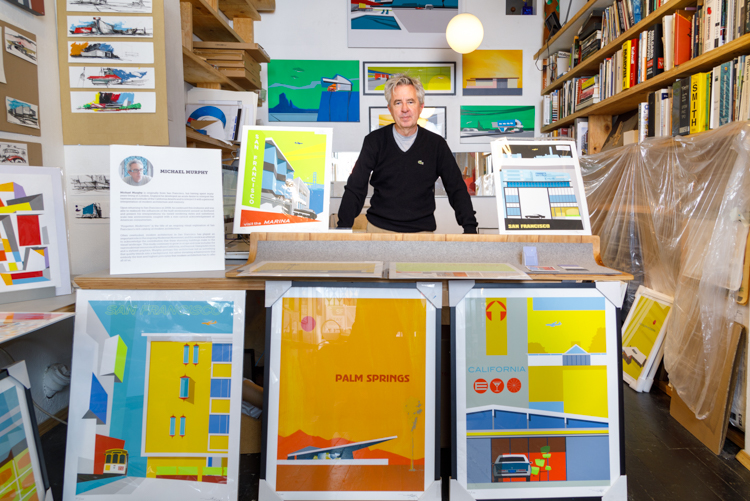
What are some of your favorite mid century modern buildings?
Besides all the amazing buildings in Palm Springs of course, I like the LAX Theme building, the Department of Water and Power in LA — it’s amazing — and the buildings at Sea Ranch.
You often have an image of an airplane in your paintings and prints. What does that mean to you?
On that same Palm Springs trip we also visited Los Angeles. I saw a poster in a shop: Fly to Hawaii. It was by the illustrator David Klein. He was responsible for the branding for TWA airlines in the late 1950-1960s. The placement of the airplane is an homage to him. He had that image in all of his work for TWA: Fly TWA to Chicago, Spain, New York and so on.
What other artists inspired you?
Ed Ruscha definitely influenced me. I loved how he could strip a building of all its distinguishing characteristics but still make it powerful.
How did you attract notice for your work?
Well, believe it or not while I was still living in London I reached out to Atomic Ranch Magazine about my work. And they did publish my work! That gave me the courage to reach out to other publications and to approach galleries to carry my work.
A key moment for me was when SFMOMA started offering my prints in their gift shop. All these opportunities led to other doors being opened for me. These days I mostly sell my pieces from my website and at my gallery but I also exhibit my work at several galleries including my most recent opening at La Luz de Jesus Gallery in Los Angeles and I have a show opening in Pasadena at Gallery 30 South.
Is it difficult to let a painting or print go?
It isn’t hard to send the prints off into the world but sometimes it is hard to let the paintings go.
The one time it wasn’t though was when I did a painting for Carol Burnett. Her husband had seen one of my prints and wanted to commission a painting of the CBS Building in Los Angeles where she had spent most of her career. He said I could mail it but I insisted that I needed to deliver it. I wanted to meet her and I did. She was as lovely a person as you think she would be.
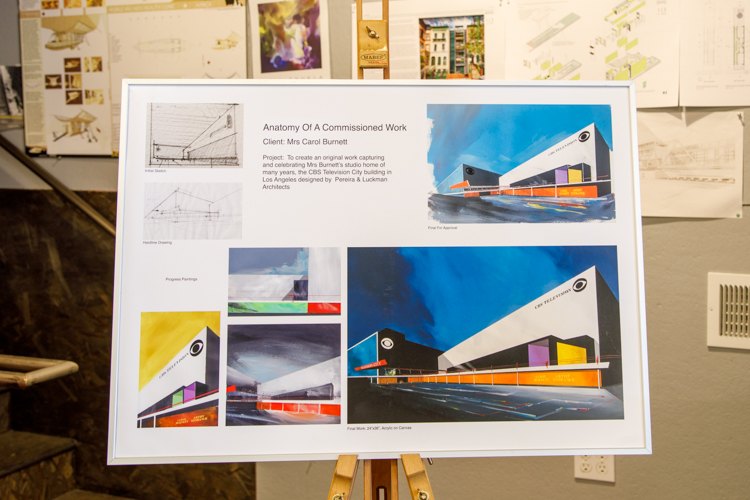
Do you miss being an architect?
I found the work I did as an architect didn’t have enough of a design aspect for me. I had learned the craft of how to build something but instead of doing that I was focused too much on building codes and such details as whether or not a hand rail was in the right place.
I find it really rewarding to be inspired and to be able to sit down and create a piece of art.
This allows me to practice architecture without all the rules and headaches. To have someone see something and want to buy it is so rewarding.
It is different from showing up and getting paycheck at work. So much more personal.
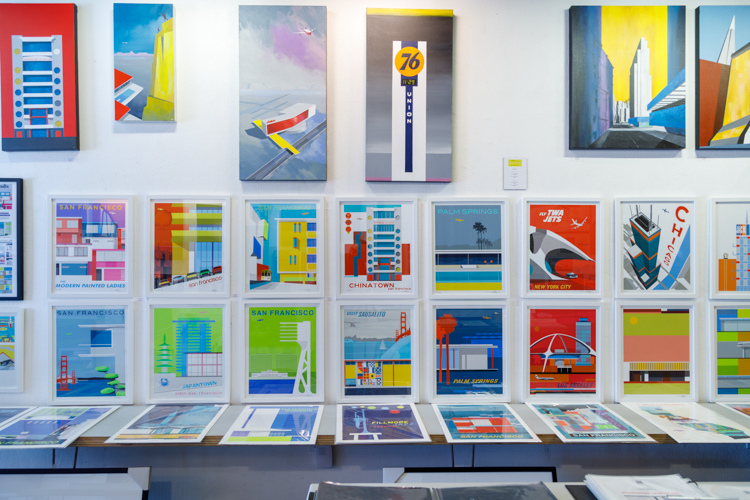
Looking for mid century-inspired art? Check out this profile of artist John Pirman or artist Danny Heller.
Of course, don’t forget to follow us on Instagram, Facebook and Pinterest for more Mid Century Modern inspiration!
About the Contributors

Patricia’s view of mid century design and lifestyle is summed up by this quote by architect William Krisel, “Midcentury modernism is not a style, it’s a language. It stays the same whether it’s spoken in 1955 or 2005. It’s a language that will always be spoken.”
Patricia and her husband, Scott, owned a Herman Miller commercial furniture
dealership in the San Francisco Bay Area for more than 20 years. The dealership introduced them to the world of midcentury design and it was love at first sight.
Patricia was also a public relations and marketing executive in Silicon Valley and in Los Angeles for more than ten years. She and her husband own a commercial photography business in San Francisco. Scott and Patricia live in the Dogpatch neighborhood of San Francisco which is home to some of the most interesting and creative people in San Francisco. Their neighborhood blog, indogpatch.com, features Patricia’s interviews and Scott’s photos of these interesting individuals.
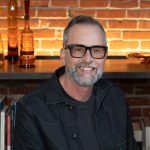
Scott is one of the premiere Executive Portrait and Headshot Photographers in the San Francisco Bay Area. In 2014, he founded SRK Headshot Day, providing individuals and companies a way to get the same high-quality headshot photography experience as Fortune 500 CEOs at locations throughout the San Francisco Bay Area and Silicon Valley. Scott is a contributing photographer at InMenlo.com and the founding photographer for Punch Magazine, where his editorial photographs portrayed the movers and shakers of Silicon Valley. He is a graduate of the Academy of Art University where he received an MFA in Photography.

